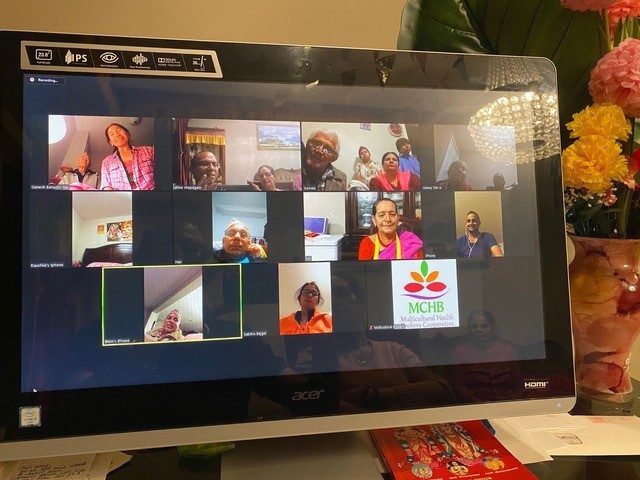The COVID-19 pandemic amplified existing inequities for Canada’s ethnocultural communities, a new study shows, with community members calling for a more inclusive approach to bridge the gaps.

The research published in the Canadian Medical Association Journal (CMAJ) Monday highlighted key challenges faced by visible minorities, immigrants and refugees living in Canada over the last year due to COVID-19.
Based on the 773 narratives collected between Sept.-Dec. 2020 in Edmonton, Alta., family violence, COVID-19 prevention, mental health and financial insecurity were the biggest concerns facing ethnocultural communities.
Researchers from the University of Alberta and Multicultural Health Brokers Cooperative (MHBC) also found that the pandemic made it more time-consuming and resource-intensive for people to support their families.
“We were able to show the pattern of the entanglements of how the cascading issues were affecting people,” said Denise Campbell, University of Alberta professor of family medicine and study co-author.
Job loss leading to food and housing insecurity was a real core issue, she said.

“Families fell into very deep poverty because our grocery run jumped from 100 to 500 very quickly and so families, after paying rent, didn’t have money for food,” said Yvonne Chiu, co-executive director of MHBC and co-author of the study.
The study adds to the growing body of research over the past year that shows that ethnic groups and racialized communities have borne the brunt of the pandemic — both physically and economically — in Canada.
A Statistics Canada report published in October 2020 found that the rate of employment to non-employment for recent immigrants peaked in April at 17.3 per cent, compared to 13.5 per cent for the Canadian born and long-term immigrants.

Meanwhile, another StatsCan report released in March 2021 showed by the end of 2020, unemployment remained higher among Indigenous people. COVID-19 mortality rates in areas with the highest proportion of population groups designated as visible minorities were also about two times higher, that same report said.
Chiu, who was born in Myanmar (formerly called Burma) and raised in Hong Kong before immigrating with her family to Canada when she was 16, said smaller communities with pre-migration refugee experience, are the most vulnerable.
“There’s a big gap between the people and how the system … proceeds with policy and program design,” she said.
“Visible minorities are actually quite invisible in many ways,” she added.

Resilience in the face of loss
Speaking from his own experience, Dr. Mawien Akot, a South Sudanese-Canadian family physician, said his community in Edmonton, has suffered “huge” losses because of the pandemic.
In Edmonton alone, among the 10 people from the South Sudanese community who died from COVID-19, the majority were young people. Since the start of the pandemic, there were 23 deaths province-wide, Akot said.
The loss of life was also a big financial strain on the community, which usually comes together to collect money for the burials, he said.
Many also lost their apartments because they did not have the income to sustain rents and were given shelter by community members. But that, in turn, also led to overcrowding in small homes, Akot said.
“The resiliency of the community and the way we responded, it sometimes has actually made the risk of COVID more worse for our individuals.”
Solutions
Funke Olokude, a Nigerian-Canadian and one of the peer researchers of the study, said going forward, policy-makers need to tap into the strengths and social capital of the ethnocultural communities.
“We need a holistic lens when we’re making policies, when we try to inform programs that it’s for all Canadians and design from the margins, so the most vulnerable are accounted for within policies as well,” Okolude told Global News.
She said community members should be included in the decision-making process, “because whatever impacts the ethnocultural communities will impact all Canadians,” she added.
Akot too stressed that not every solution is tailor-made.
“For example, when the government moved into digital communication for services, there is an underlying assumption that everybody knows how to use computers,” he said.
“But there are many people in our communities that do not know how to log into a computer, do not know how to read or write.”
That is why we need help to navigate the system, he said.
Chiu said trusted intermediaries embedded in the communities could help bridge the gaps that were magnified by the COVID-19 pandemic.
“We need intermediaries who could connect mainstream system and policymakers for those who are not so visible and marginalized,” she said.
“That is really what we continue to strive for and .. COVID gave us a greater need to do this.”
- Canadian man dies during Texas Ironman event. His widow wants answers as to why
- Invasive strep: ‘Don’t wait’ to seek care, N.S. woman warns on long road to recovery
- ‘Super lice’ are becoming more resistant to chemical shampoos. What to use instead
- Canadians more likely to eat food past best-before date. What are the risks?







Comments